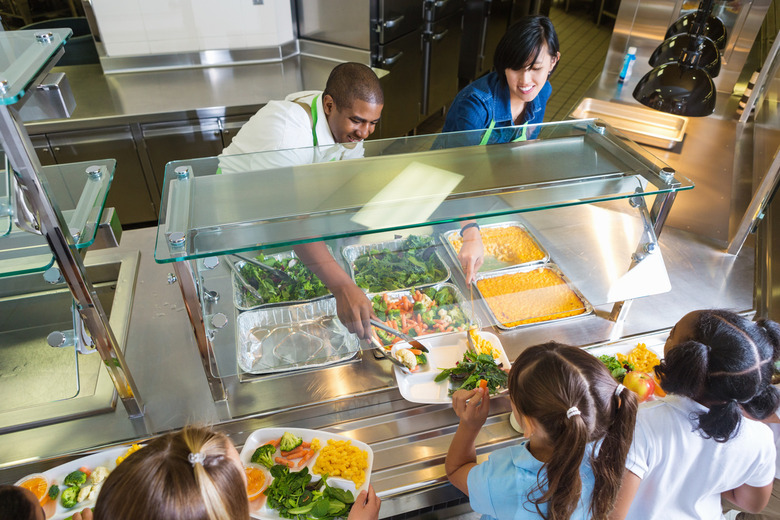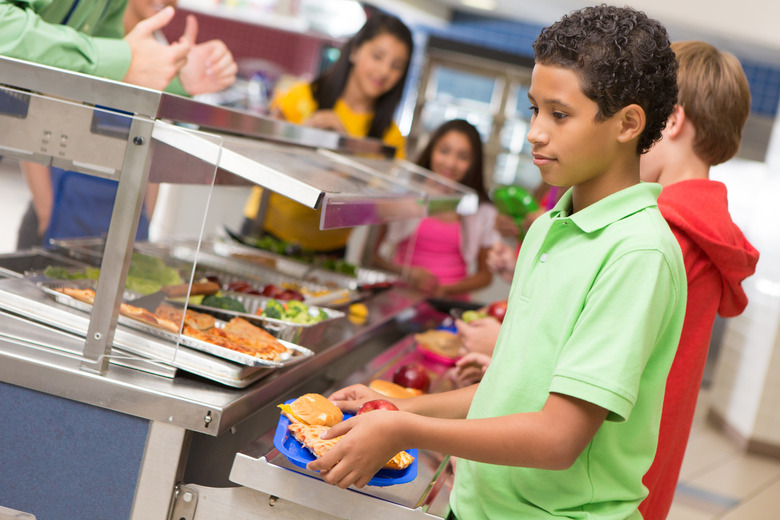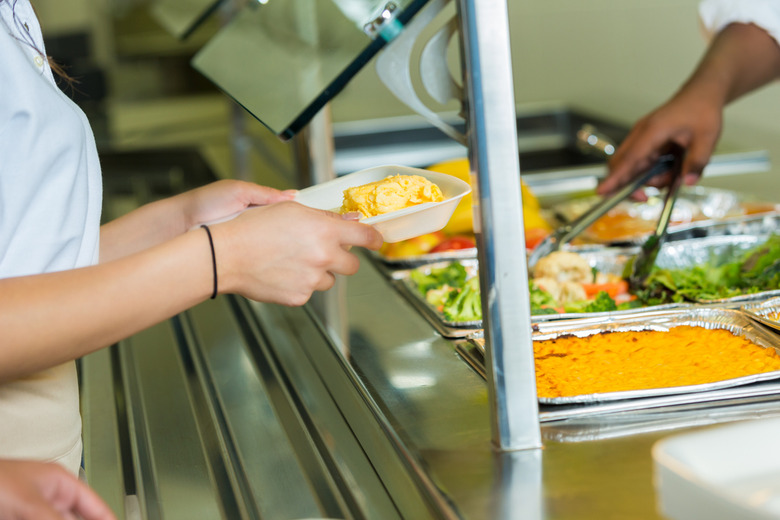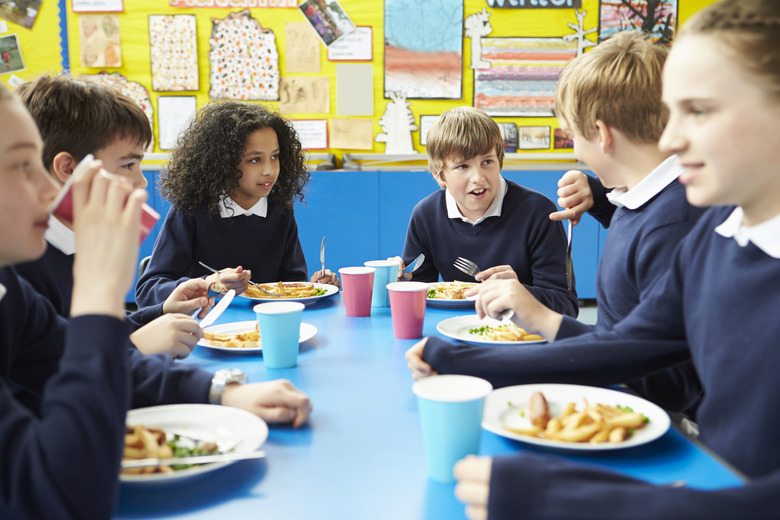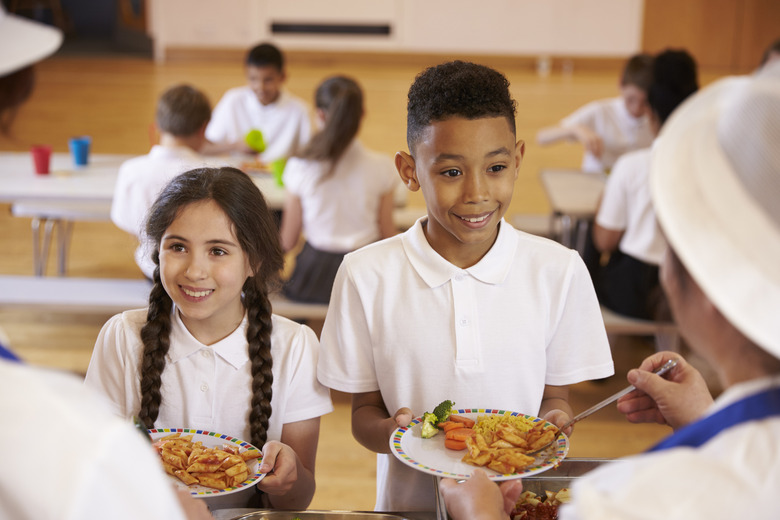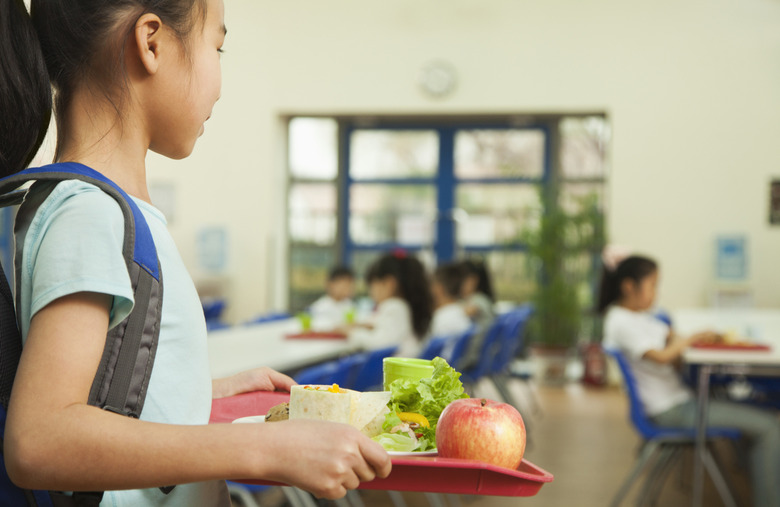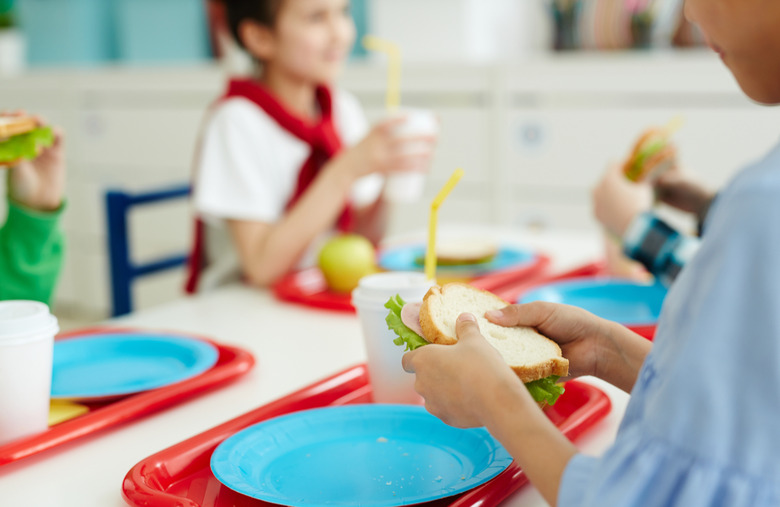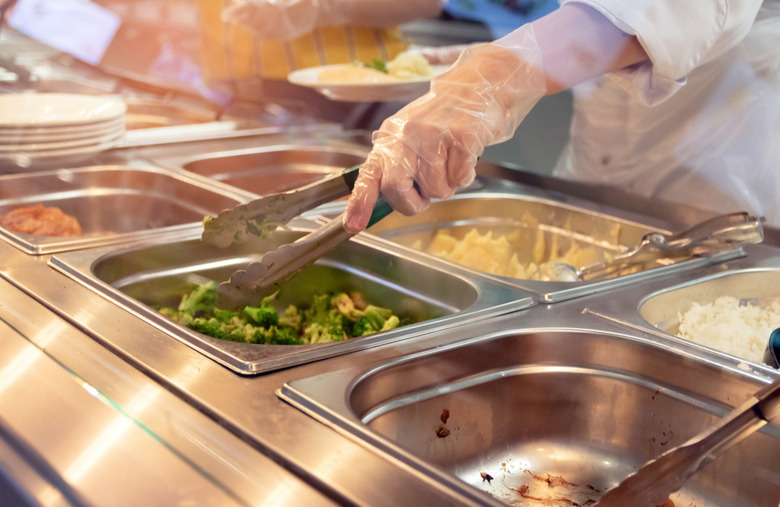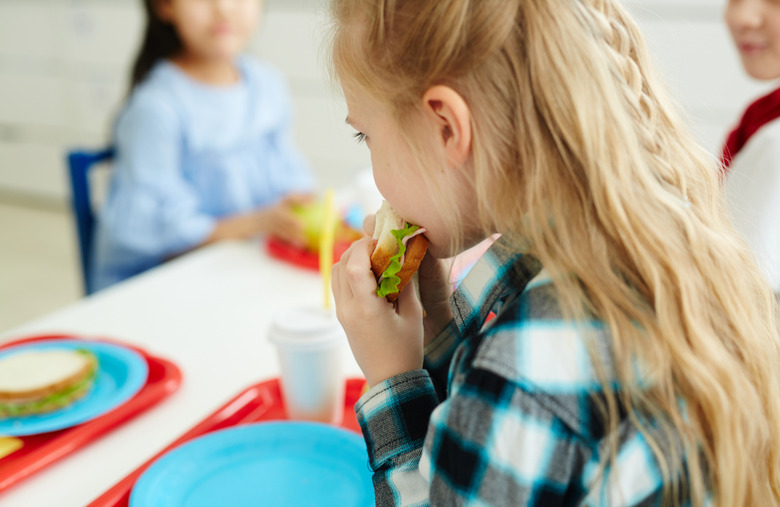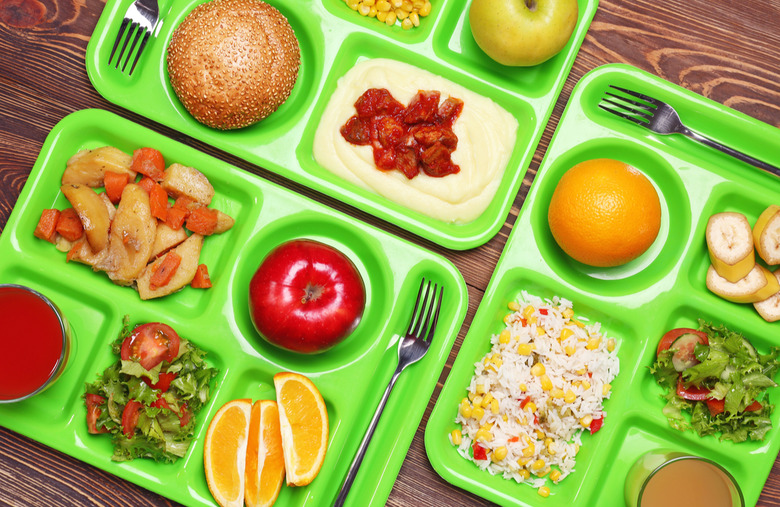A State-By-State Guide To Free And Reduced School Meal Programs
It's common knowledge that kids need proper nutrition to grow and thrive — and that they need the right fuel to succeed in school. But even in the United States, not all children have stable access to nutritious food — nearly 16 percent of households with kids experienced food insecurity in 2017, the most recent year reported by the Department of Agriculture. While programs like SNAP exist to help keep families fed at home, free and reduced-price meals at school fill a critical role for millions of kids nationwide.
"The school breakfast and lunch programs help to ensure that low-income children receive nutritious meals that support learning, health and development," Crystal FitzSimons, director of school and out-of-school time programs for the Food Research and Action Center (FRAC), a nonprofit focused on eradicating hunger in the U.S., told The Daily Meal via email. "Participation in these important programs is linked to improved academic achievement, better attendance and behavior at school, and improved health and mental outcomes."
The huge scale of these programs is part of why they've been so effective. The National School Lunch Program (NSLP), which is administered by the USDA's Food and Nutrition Service (FNS), served nearly 30 million lunches to students every day on average in 2018, and almost three-quarters of those were provided either at no charge or at a reduced price. In the same year over 14 million meals — 85 percent of which were free or reduced — were served daily through the related School Breakfast Program, which advocates say can have an equally powerful effect on students' health and academic success.
The USDA's standards ensure that students are offered healthy meals, but states and schools have leeway regarding precisely which foods are served to students. The federal government provides a reimbursement for each meal served — including a small subsidy for meals served at full price — and also directly delivers U.S.-grown agricultural products to schools.
FNS also provides after-school snacks through the NSLP and administers the Summer Food Service Program, which operates at a variety of sites (including schools) to keep kids fed during the summer, and the Special Milk Program, which provides milk to schools and child-care sites that don't participate in other federal meal programs.
Here's a look at programs on a federal level, followed by how your state differs.
Eligibility for free and reduced-price meals
For parents wondering whether their children are eligible for free or reduced-price meals at school, the best way to find out is to check with the school. Schools that participate in federal meal programs are required to reach out to notify families about the availability of programs. Some resources for families are also available on the FNS website.
Many students can receive free meals based simply on the school they attend. Just over the last decade, more and more students have become eligible through what's called the Community Eligibility Provision (CEP), which enables many schools and districts to offer free lunch to all students without processing individual applications.
In other schools that participate in the NSLP, federal guidelines set the standard regarding which students are eligible. There are three ways students can qualify.
Income level
Students can be eligible for free or reduced lunch based on family income — the cutoffs are determined based on the federal poverty level (at 130 percent of poverty level for free meals and 185 percent for reduced-price meals). These income levels vary by family size, but they can be viewed in this chart from the Government Publishing Office.
Categorical eligibility
Students are also automatically eligible for assistance based on participation in some other government assistance programs. Free lunch is available to all students who participate in the Supplemental Nutrition Assistance Program, the Temporary Assistance for Needy Families program or the Food Distribution Program on Indian Reservations, for instance. Categorical eligibility also applies to homeless, migrant, runaway and foster children, as well as any child enrolled in a federally funded Head Start program or a comparable state-funded pre-K program.
Community eligibility
As previously mentioned, the Healthy, Hunger-Free Kids Act of 2010 made it possible for a school or district to offer meals to all students free of charge if over 40 percent of its students are categorically eligible; this both expands access to meals for students and lowers some administrative costs for schools. Schools are reimbursed by the federal government based on their specific percentage of eligible students, and school districts are required to cover the remaining cost, so not all eligible districts elect to participate — but by 2016, 50 percent of eligible schools nationwide had adopted community eligibility, according to the nonprofit Center on Budget and Policy Priorities.
How programs differ between states
The same federal eligibility rules for students apply nationwide, but many anti-hunger advocates and educators say students would benefit greatly from even more robust programs. "Ideally, there would be funding to serve all students free meals," Diane Pratt-Heavner, director of media relations for the School Nutrition Association, told The Daily Meal via email.
As such, certain states have policies designed to expand access for students. West Virginia, for instance, requires all schools to offer breakfast outside the cafeteria and integrated into the school day schedule, earning it a higher rate of school breakfast participation than any other state. Similar "breakfast after the bell" or "grab and go" breakfast policies have been encouraged elsewhere to eliminate stigma and ensure that all students get a morning meal.
While some states don't even require all schools to serve meals or participate in federal programs, parents in some other states may be pleased to learn that their state provides funding to eliminate the fee for reduced-price meals. Many states encourage or require certain schools to offer free meals to all students. And 11 states to date have passed rules to prohibit mistreatment of students based inability to pay for meals — often referred to as "lunch shaming" — an issue that has increasingly been in the news in recent years.
The Daily Meal looked at information from the Food Research and Action Center, the Center on Budget and Policy Priorities, the School Nutrition Association, and state and federal governments to see how each state matches up.
Alabama
The Yellowhammer State doesn't require that schools participate in the NSLP, but among those that do, over 97 percent serve breakfast as well as lunch.
Alaska
The NSLP reimburses Alaska schools for meals at a higher rate than any other state because of higher food costs on the Last Frontier — in 2018-19, schools in the state received $5.38 for each free meal served, as compared to $3.31 in the 48 contiguous states. Eligibility rules for students, however, match the federal standard.
Arizona
Arizona requires all K-8 schools to participate in the NSLP. A relatively low percentage of schools in the state take advantage of community eligibility; despite nearly 80 percent of schools being eligible, only 34 percent have adopted CEP.
Arkansas
Arkansas requires all schools with 20 percent or more students eligible for free or reduced meals to offer breakfast. In 2019, Arkansas became the 11th state to pass a law prohibiting retributive action against students who owe school lunch debt for unpaid meals.
California
California requires all schools to provide at least one meal per day to eligible students, and schools with more than 62.5 percent of students eligible for free or reduced meals must offer free meals to all students. The Golden State prohibits punishment of unpaid school debt and offers grant programs to encourage schools to upgrade equipment, expand summer programs and provide students with fresh California produce.
Colorado
Colorado provides funding to eliminate the reduced-price fee for eligible students for both breakfast and lunch, and schools with more than 70 percent eligible students are required to provide "breakfast after the bell," which incorporates free breakfast into the school day schedule.
Connecticut
Connecticut requires schools with high participation in free and reduced lunch to offer breakfast as well. The state also provides grants and subsidies to encourage schools to serve breakfast, and an additional 10 cents per meal served to schools that adhere to state nutritional standards.
Delaware
Delaware requires all schools that have adopted community eligibility to offer "grab and go" or "breakfast after the bell" morning options in addition to cafeteria service. The state also subsidizes the salaries of school food service staff.
Florida
All public schools in the Sunshine State are required to offer breakfast, and schools with over 80 percent of students eligible for free or reduced meals must offer it at no charge and are encouraged to make the meal available outside the cafeteria.
Georgia
Georgia requires all public schools to participate in NSLP. All schools with 40 percent or more students eligible for free or reduced meals (and K-8 schools with 25 percent or more) must establish a breakfast program. The state provides funding to offset food service staff labor costs.
Hawaii
All Aloha State schools where students are required to eat lunch at school must offer both breakfast and lunch. Students can't be denied meals during the first 21 days of school regardless of their ability to pay, and are given a seven-day grace period after that.
Idaho
Around 66 percent of eligible schools in Idaho offer free meals to all students through community eligibility.
Illinois
Illinois requires all public schools to operate a lunch program that provides free meals to eligible students. Schools with more than 40 percent of students eligible for free or reduced meals must offer breakfast, and schools with 70 percent or more eligible must offer breakfast for all students during the school day. The state government authorized a 15-cent supplemental reimbursement for each free meal served, but budget shortfalls have resulted in the rate dropping to 4 cents in the 2018-19 school year.
Indiana
Indiana requires schools to serve breakfast if more than 15 percent of students are eligible for free or reduced lunch.
Iowa
Iowa schools are required to provide lunch that meets NSLP nutrition standards. The Hawkeye State prohibits schools from stigmatizing students who cannot pay for meals.
Kansas
Kansas requires all public schools to participate in the School Breakfast Program and provides an additional 4-cent subsidy for each lunch served.
Kentucky
Kentucky became eligible for the community eligibility provision during the first year of the pilot program, and by the 2015-16 school year, over 80 percent of eligible schools and over 90 percent of highest-poverty schools had adopted free meals for all students. The Bluegrass State prohibits schools from discriminating against students who cannot pay for meals.
Louisiana
All public schools in Louisiana must provide a lunch program, and all schools in which over 25 percent of students are eligible for free or reduced meals must serve breakfast. Louisiana requires schools to complete elaborate documentation in order to deny any student a meal for nonpayment of fees.
Maine
Maine requires all K-8 public schools to participate in the NSLP, and all schools in which more than 50 percent of students qualify for free or reduced meals must offer breakfast after the bell. The state provides funding to eliminate the reduced-price fee for both breakfast and lunch, and requires schools to provide a meal to any student who requests it regardless of the student's ability to pay and prohibits stigmatizing students who cannot.
Maryland
Maryland requires all public schools to operate free and reduced-price programs for both breakfast and lunch. The state also offers additional funding for CEP-eligible schools to offer breakfast after the bell and is phasing in a program to cover fees for reduced-price meals at all schools.
Massachusetts
All Massachusetts public schools must make lunch available, and all severe-need schools are required to participate in the federal breakfast program. The state provides schools with additional reimbursement for all lunches, as well as incentives for schools to offer free breakfast for all students.
Michigan
Michigan requires all public schools to participate in the NSLP, and schools in which more than 20 percent of students are eligible for subsidized meals must participate in the federal breakfast program. The state offers supplemental reimbursements for both breakfast and lunch and for schools that serve Michigan-grown produce in certain counties.
Minnesota
Minnesota requires all schools in which more than one-third of lunches served are free or reduced to participate in the federal breakfast program. The state provides funding to eliminate the fee for reduced-price meals and to provide free breakfast in all kindergarten and voluntary pre-K programs.
Mississippi
The Magnolia State does not require schools to participate, but 60 percent of eligible schools provide free meals to students through the community eligibility provision.
Missouri
The Show Me State requires schools with more than 35 percent subsidy-eligible students to offer breakfast through the federal program, and the state requires programs to implement outreach programs to serve at-risk populations.
Montana
Eighty-five percent of eligible schools in Montana — over 60 percent of schools in the state overall — offer free meals to all students through the Community Eligibility Provision.
Nebraska
Relatively few Nebraska schools — only around 8 percent — offer community eligibility for free meals, and the state has one of the lowest school breakfast participation rates in the nation.
Nevada
The Silver State requires schools with 70 percent or more students eligible for free or reduced meals to provide breakfast after the bell, and the state offers startup grants to help schools implement the program.
New Hampshire
The Granite State requires all schools to provide a meal during the day, offers additional reimbursement to cover fees for reduced-price breakfasts, and prohibits schools from treating students differently based on their ability to pay.
New Jersey
Starting with the 2019-2020 school year, New Jersey will require all schools with over 70 percent subsidy-eligible students to offer breakfast after the bell, though schools that already have high participation in the federal School Breakfast Program may request a waiver.
New Mexico
New Mexico requires high-need schools — those in which over 85 percent of students are eligible for free or reduced-price meals — to provide breakfast after the bell, and offers grants to support participating schools. The state requires schools to provide meals to children regardless of their ability to pay and prohibits shaming of students who cannot.
New York
New York requires schools in which more than 70 percent of students are eligible for free or reduced meals to offer breakfast after the bell and allows for time spent feeding students to be considered instructional time. The Empire State prohibits shaming students based on their ability to pay for meals.
North Carolina
The Tar Heel State requires public schools to participate in the NSLP and offers state funds to eliminate fees for reduced-price breakfast. Schools that serve breakfast after the bell may count mealtime as instructional time as long as educational activity is taking place simultaneously.
North Dakota
North Dakota has a high rate of adoption for community eligibility. The state also provides funds to cover the fee for reduced-price breakfast.
Ohio
Ohio requires all schools in which 20 percent of students are eligible for free meals to participate in both federal lunch and breakfast programs.
Oklahoma
Oklahoma does not require schools to participate in federal meal programs, but the state does prohibit schools from withholding academic records from students with meal debt.
Oregon
Oregon requires schools with more than 70 percent of students eligible for free or reduced-price meals to offer breakfast after the bell, and the state prohibits shaming students based on meal debt. In 2019 the state legislature passed an ambitious measure to drastically expand access to free meals for students; the measure would take effect in fall 2020 if it passes an upcoming ballot referral.
Pennsylvania
The Keystone State offers modest reimbursements to schools for each meal served, and the state requires schools to provide meals to all students regardless of their ability to pay and prohibits shaming.
Rhode Island
Rhode Island requires all public schools to serve breakfast and lunch.
South Carolina
All Palmetto State public schools are required to participate in both the National School Lunch Program and the School Breakfast Program.
South Dakota
Sixty percent of eligible South Dakota schools offer free meals through the community eligibility provision.
Tennessee
Tennessee requires all public schools to operate a school lunch program, and requires K-8 schools with 25 percent of students eligible for free or reduced meals (or 40 percent for high schools) to participate in the federal breakfast program.
Texas
The Lone Star State has been a leader in school breakfast programs; nearly all (99.8 percent) of the state's schools that offer lunch also offer breakfast, the highest rate in the country. Texas schools at which 80 percent of students are eligible for free or reduced meals are required to offer free breakfast to all students.
Utah
Utah does not require schools to participate in meal programs. The Beehive State has the nation's lowest rate of student participation in school breakfast.
Vermont
Vermont requires all public schools to participate in federal breakfast and lunch programs, and the state provides funds to eliminate fees for reduced-price meals.
Virginia
Virginia requires schools at which more than 25 percent of students are eligible for free or reduced-price meals to participate in the SBP. The state requires local school boards to adopt policies that prohibit meal debt shaming.
Washington
Washington provides funds to eliminate the fee for reduced-price lunch for students up to the third grade, and for breakfast for all students. The state requires schools with more than 70 percent of students eligible for free or reduced meals to establish a breakfast after the bell program.
Washington, D.C.
The District of Columbia provides funding to eliminate the fee for reduced-price lunches, and requires all schools with more than 40 percent of students eligible for free or reduced-price lunches to provide breakfast in the classroom.
West Virginia
West Virginia requires all schools to offer free breakfast outside the cafeteria for all students, and the state consistently leads the nation in breakfast participation. The state became eligible for the Community Eligibility Provision during the second year of the pilot program, and 86 percent of eligible schools had adopted the program as of 2016.
Wisconsin
Wisconsin does not mandate participation in federal meal programs, but the state does require that schools provide a meal to any student who requests it and prohibits shaming for students who cannot pay.
Wyoming
Wyoming does not require schools to participate in federal meal programs.
More from The Daily Meal:
Kids Weigh in on Their Most and Least Favorite Packed School Lunches
25 Foods That Are Perfect for Your Child's Lunchbox
25 Childhood Desserts You Forgot Existed

